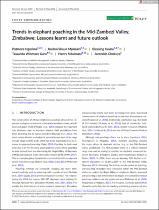| dc.contributor.author | Mpakairi, Kudzai Shaun | |
| dc.contributor.author | Ngorima, Patmore | |
| dc.contributor.author | Blessing, Kavhu | |
| dc.contributor.author | Gara, Tawanda Winmore | |
| dc.date.accessioned | 2023-07-11T10:25:12Z | |
| dc.date.available | 2023-07-11T10:25:12Z | |
| dc.date.issued | 2023 | |
| dc.identifier.citation | Gara, T.W., Ndaimani, H. and Chakuya, J., 2022. Trends in elephant poaching in the Mid-Zambezi Valley, Zimbabwe: Lessons learnt and future outlook. | en_US |
| dc.identifier.uri | https://doi.org/10.1111/aje.13039 | |
| dc.identifier.uri | http://hdl.handle.net/10566/9193 | |
| dc.description.abstract | Background: The conservation of African elephants (Loxodonta africana) has important ecological, economical, cultural and aesthetic values, at both local and global levels (Pittiglio et al., 2014). Despite the important role elephants play as keystone species, their populations have been dwindling due to human activities (Sibanda et al., 2016). The most serious threats to elephant's survival across most of its range include illegal wildlife trade which has been exacerbated by an increase in organized poaching (Ouko, 2013). Poaching for both meat and ivory is by far the most acute problem across Africa according to data derived from the Monitoring the Illegal Killing of Elephants (MIKE) and Elephant Trade Information System (ETIS; WWF, 2017). This is a complex global threat to the survival of the African elephant across most of its range (Dejene et al., 2021; Ouko, 2013; Wittemyer et al., 2014). | en_US |
| dc.language.iso | en | en_US |
| dc.publisher | African Journal of Ecology | en_US |
| dc.subject | African elephants | en_US |
| dc.subject | Poaching | en_US |
| dc.subject | Zimbabwe | en_US |
| dc.subject | Wildlife | en_US |
| dc.subject | Mid-Zambezi Valley | en_US |
| dc.title | Trends in elephant poaching in the Mid-Zambezi Valley, Zimbabwe: Lessons learnt and future outlook | en_US |
| dc.type | Article | en_US |

